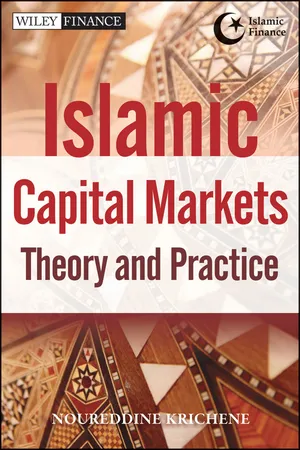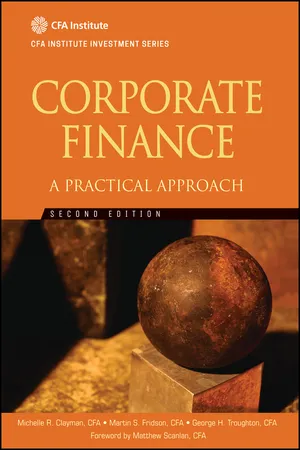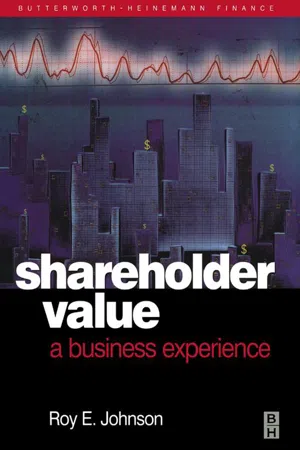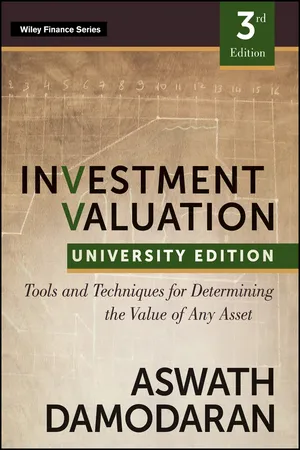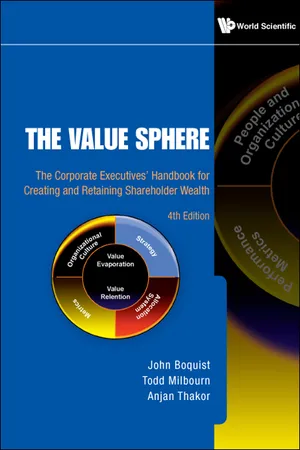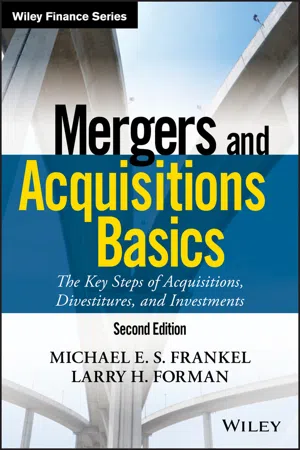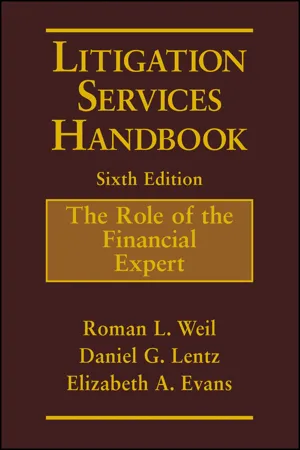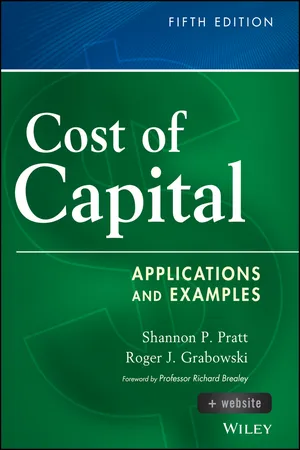Business
Cost of Equity
Cost of equity refers to the return that investors require for holding a company's stock. It is a key component in determining a company's overall cost of capital and is used in various financial calculations, such as valuation and investment decision-making. The cost of equity is influenced by factors such as the company's risk profile, market conditions, and investor expectations.
Written by Perlego with AI-assistance
Related key terms
Related key terms
1 of 4
Related key terms
1 of 3
11 Key excerpts on "Cost of Equity"
- eBook - ePub
Islamic Capital Markets
Theory and Practice
- Noureddine Krichene(Author)
- 2012(Publication Date)
- Wiley(Publisher)
Each component of an entity’s capital structure has its unique cost, depending primarily on its respective risk. The cost of capital can be viewed from three different perspectives. On the asset side of a firm’s balance sheet, it is the rate that should be used to discount to a present value the future expected cash flows. On the liability side, it is the economic cost to the firm of attracting and retaining capital in a competitive environment, in which investors (capital providers) carefully analyze and compare all return-generating opportunities. On the investor’s side, it is the return one expects and requires from an investment in a firm’s debt or equity. While each of these perspectives might view the cost of capital differently, they are all dealing with the same number.When we talk about the cost of ownership capital (e.g., the expected return to a stock) we usually use the phrase Cost of Equity capital. The Cost of Equity is the rate of return investors require on equity investment in a firm. When we talk about the cost of capital to the firm overall (e.g., the average cost of capital for both equity and debt), we commonly use the term weighted average cost of capital (WACC). The cost of capital applies to both debt and equity investment. Since free cash flow is the cash flow available to all financial investors (debt, equity) the company’s weighted average cost of capital includes the required return for each investor.The cost of capital is a function of investment. The true cost of capital depends on the use to which the capital is put; it does not depend on the source of funding. This is the Modigliani–Miller principle, which asserts that the cost of capital for a firm is independent of the source of financing. Each project should, in principle, be evaluated at its own opportunity cost of capital. When a company uses a given cost of capital to evaluate a commitment of capital to an investment or project, it often refers to that cost as the hurdle rate. The hurdle rate is the minimum expected rate of return that the company would be willing to accept to justify making the investment. - eBook - ePub
- Alan Reynolds(Author)
- 2013(Publication Date)
- Routledge(Publisher)
Past Performance. Another approach to the Cost of Equity is through financial results reported in earlier years. A specific company can be assessed in this way, or one of its business segments, or the entire industrial sector of which it is a part. Several measures of a company’s performance might be selected.We start with Earnings, which incorporates both retained profit and dividends. This quantity can be converted into the equivalent of an interest rate by dividing the earnings per share by the market price per share:This ratio has the disadvantage of changing as the share price fluctuates, but an average value can be chosen. In its favour, we note that the market price is not an arbitrary accounting quantity, but expresses the cumulative judgement of numerous investors.Another way of characterising earnings is through its relationship to shareholders’ funds:Although this ratio is commonly called Return on Equity, it may not be the ‘Cost of Equity’ that we hope to find. We have seen (Sections 5.6 and 6.2 ) that SHF is a somewhat arbitrary quantity, strongly influenced by a company’s policies on writing-off and revaluation.We can also relate earnings to quantities defining a company’s capital, and specifically to net assets, which is equal to capital employed: This divisor is somewhat better defined, but it may seem perverse to base the return on equity on the sum of equity and loan capital.In using any of the proposals of Equations (7.7) to (7.9), we must allow for the tax that is entered in the profit and loss statement before the earnings are struck. This suggests that, for typical rates of taxation, the Cost of Equity may be some 40 per cent higher than the values given by these equations.Finally, we might combine the current dividend, which is received immediately, and the anticipated future growth of the company, which can be estimated from past performance. Summing these components, we haveThe present dividend is known, but the second term is less certain. Should it be based on growth in earnings? In turnover? In assets? What period of time should be considered? How do we allow for that part of the growth that comes from the injection of additional capital? For a company with reasonably stable capital and capital structure, the growth in EPS over, say, the past decade might be taken to represent its performance. - eBook - ePub
Corporate Finance
A Practical Approach
- Michelle R. Clayman, Martin S. Fridson, George H. Troughton(Authors)
- 2012(Publication Date)
- Wiley(Publisher)
- The dividend discount model approach is an alternative approach to calculating the Cost of Equity, whereby the Cost of Equity is estimated as follows:
- We can estimate the growth rate in the dividend discount model by using published forecasts of analysts or by estimating the sustainable growth rate:
- In estimating the Cost of Equity, an alternative to the CAPM and dividend discount approaches is the bond yield plus risk premium approach. In this approach, we estimate the before-tax cost of debt and add a risk premium that reflects the additional risk associated with the company’s equity.
- The marginal cost of capital schedule is a graph plotting the new funds raised by a company on the x -axis and the cost of capital on the y -axis. The cost of capital is level to the point at which one of the costs of capital changes, such as when the company bumps up against a debt covenant, requiring it to use another form of capital. We calculate a break point using information on when the different sources’ costs change and the proportions that the company uses when it raises additional capital:
- Flotation costs are costs incurred in the process of raising additional capital. The preferred method of including these costs in the analysis is as an initial cash flow in the valuation analysis.
- Survey evidence tells us that the CAPM method is the most popular method used by companies in estimating the Cost of Equity. The CAPM is more popular with larger, publicly traded companies, which is understandable considering the additional analyses and assumptions required in estimating systematic risk for a private company or project.
PROBLEMS1. The Cost of Equity is equal to the: A. expected market return. B. rate of return required by stockholders. C. cost of retained earnings plus dividends. 2. Which of the following statements is correct? - eBook - ePub
- RoyE. Johnson(Author)
- 2001(Publication Date)
- Butterworth-Heinemann(Publisher)
Jason, unaware of what was going in Jack’s mind, continued … “Common stocks have a wide range of returns with respect to individual companies, since there are thousands that are publicly owned and traded. Overall, stocks have produced an annual rate of return over the past sixty or so years that has averaged approximately five percentage points higher than the return for government bonds. This is the ‘reward’ that equity investors have experienced (and enjoyed) by holding on to their stocks. This is called the ‘market risk premium’. Why do we use this term? The reason is that the experience of the ‘market’ has become a requirement for managers who have been entrusted with equity capital. This is an important point, and I plan to discuss it in more depth shortly”.“If we take all the points on this ‘stock market theory’ chart (Exhibit 10 ), we can construct the following formula to calculate the Cost of Equity capital for the overall stock market:Cost of Equity equals the risk − free rate plus the market riskpremium .In our example, at the bottom of Exhibit 10 , based on a government bond rate in the range of 6.5%, the return for the overall stock market is approximately 11.5%. This is the annual rate of return an investor would expect from an ‘indexed’ mutual fund, which represents a broad stock market average such as the Standard & Poor’s (S&P) 500”.“OK, so far so good and not controversial”, Jill interjected, realizing that it had been quite a while since she had spoken. “But, what about Jack’s earlier comment about ‘beta’?”“We’re just about there”, Jason responded. While Jason spoke, Jack sat up and again placed his arms on the top of the conference table, thinking to himself … “maybe this will be interesting ” … and also thinking how much he liked to have his direct reports either responding positively to or supporting his positions.Jason, moving ahead on his own agenda, continued … “The controversy comes in calculating an individual firm’s risk, or ‘beta’. So, what we’re talking about is the accuracy of the Cost of Equity capital calculation for a company. We’ve established that equity capital is the most expensive form of capital, which is why we need to include it in any evaluation of management performance or in the analysis of a business strategy, new business venture or acquisition. This is what Earl, Frank and I were talking about this morning when we said that the Cost of Equity capital is important. This morning, we focused on the fact that this cost is not readily apparent in our financial statements; in essence, it is ‘hidden’. Now this situation is compounded by the fact that the Cost of Equity capital is clearly the ‘most expensive’, regardless of its actual cost. The argument centers on the ‘beta’ statistic being an accurate measure of the volatility for the stock price of an individual company versus the ‘market’ – the ‘market’ having a ‘beta’ of 1.0. Thus, the debate boils down to whether the company specific risk is, for example, 0.8 or 1.2. By working through the formula in the example on the screen (Exhibit 10 - eBook - ePub
Investment Valuation
Tools and Techniques for Determining the Value of any Asset, University Edition
- Aswath Damodaran(Author)
- 2012(Publication Date)
- Wiley(Publisher)
FROM Cost of Equity TO COST OF CAPITALWe would introduce four notes of caution with this approach. First, this opens the door to a series of adjustments that you could make to the Cost of Equity, reflecting the numerous inefficiencies cited in Chapter 6. For instance, you could estimate a low PE premium, a low price-to-book premium, and a high dividend yield premium and add them all to the Cost of Equity. If our objective in valuation is to uncover market mistakes, it would be a mistake to start off with the presumption that markets are right in their assessments in the first place. Second, a better way of incorporating the small firm premium would be to identify the reasons for the premium and then develop more direct measures of risk. For instance, assume that the higher risk of small cap stocks comes from the higher operating leverage that these firms have, relative to their larger competitors. You could adjust the betas for operating leverage (as we did a few pages ago for Vans Shoes) and use the higher betas for small firms. Third, the small cap premium of 4 percent that we estimated from historical data comes with a significant standard error (of approximately 2 percent). Thus, the true small cap premium can be 8 percent or 0 percent. Fourth, even if your company is a small company today and deserves a small cap premium, assuming a high growth rate for your firm will make it a large cap firm eventually. It follows that you would expect the small cap premium to fade over time.Although equity is undoubtedly an important and indispensable ingredient of the financing mix for every business, it is but one ingredient. Most businesses finance some or much of their operations using debt or some security that is a combination of equity and debt. The costs of these sources of financing are generally very different from the Cost of Equity, and the cost of financing for a firm should reflect their costs as well, in proportion to their use in the financing mix. Intuitively, the cost of capital is the weighted average of the costs of the different components of financing—including debt, equity, and hybrid securities—used by a firm to fund its financial requirements. This section examines the process of estimating the cost of financing other than equity, and the weights for computing the cost of capital. - eBook - ePub
The Value Sphere
The Corporate Executives' Handbook for Creating and Retaining Shareholder Wealth
- John Boquist, Todd Milbourn, Anjan Thakor(Authors)
- 2009(Publication Date)
- WSPC(Publisher)
“Second, the total cash flow to all capital providers, earnings after-tax to shareholders and interest to lenders, are $40 higher ($240 vs. $280). Note that the increase in payments to a capital providers, both equity and debt, of $40 is equal to $100 × (0.4). In symbols, the amount is iDT, where iD is the interest paid, calculated by multiplying the interest rate, i, times the amount borrowed D, and T is the corporate tax rate. This increase in the firm's total cash flow because of the tax deductibility of debt interest is important to the valuation of the firms. Firms that borrow money have higher valuations than those that do not borrow, everything else equal.”4. Equity FinancingBob began, “Now, let's look at the Cost of Equity. The most widely used method of determining the Cost of Equity financing is to use the capital asset pricing model, known as the CAPM.58 The CAPM specifies that the Cost of Equity capital is equal to the return expected on the firm's common stock, and can be written as:Equity cost of capital = Risk-free rate +[Stock's beta × Market risk premium]where the 30-year US Treasury bond rate is used to proxy for the risk-free rate. “In this model, it is the beta coefficient that is unique to each stock. Everything else is common to all stocks traded on US exchanges.” “Hold on, Bob. You need to slow down and explain this beta and risk premium stuff,” said Jerry.Bob responded quickly. “Sure, Jerry. The Cost of Equity capital has two elements: the first is compensation for the pure time value of money which is represented by the risk-free rate. And the second is compensation for the risk in investing in a particular stock that is given by beta times the market risk premium. Note that the market risk premium is the additional return over and above the risk-free rate that investors demand for investing in the stock market as a whole. An example of an overall stock market risk is that occurring after the internet bubble collapsed. A stock's beta measures how risky the stock is relative to the whole market.”Jerry nodded. “Bob, I want to know a bit more about this beta coefficient. It is a mystery to me.” - eBook - ePub
Mergers and Acquisitions Basics
The Key Steps of Acquisitions, Divestitures, and Investments
- Michael E. S. Frankel, Larry H. Forman(Authors)
- 2017(Publication Date)
- Wiley(Publisher)
junk, bonds are debt securities offered to the market by companies where there is a greater risk of default.While the cost of debt is an actual number, the Cost of Equity is more ambiguous. As a general matter, the return on equity expected by the market on the company's stock is a good shorthand for the Cost of Equity. That is, if the market expects the company's stock to appreciate by 10 percent per year, this is a good estimate of the Cost of Equity, since, theoretically, that gain would have been “kept” by the company if the equity had not been issued.The cost of either equity or debt is also affected by the market as a whole. The rate of return expected for equity, and the interest charged for debt, is really a combination of the base market rate and a risk premium associated with the particular company. Therefore, as interest rates rise and fall, and as market expectations of return on equity change, the Cost of Equity or debt for a particular company will move in sync. Similarly, market expectations for a particular industry can affect the cost of debt or equity. Separate from the risk of the issuing company, a market perception of changes in the risk of the sector can cause it to charge an issuer in that sector more or less for equity or debt financing.All of the financing tools discussed apply not only to acquisitions but also to a company's capital needs. From investment in technology to building new plants, a company's operations are, by definition, either funded from cash the company has on hand or from some form of equity or debt financing. As a result, it is silly to consider acquisition financing in a vacuum. This would be like thinking of the money in your left pocket as separate from the money in your right pocket. It is all your money, and you can move it from pocket to pocket at will. Instead, a company looks at its overall capital needs and capital sources. As a result, when considering the financing of an acquisition, a Buyer should factor in the general cost of capital for the company. And any acquisition's or investment's performance must net out the cost of capital applied to that deal. - eBook - ePub
Litigation Services Handbook
The Role of the Financial Expert
- Roman L. Weil, Daniel G. Lentz, Elizabeth A. Evans(Authors)
- 2017(Publication Date)
- Wiley(Publisher)
Section 10.4(c) discusses methods for estimating the cost of capital appropriate for a company’s assets.Company BetaCost of EquityWal-Mart 0.64 6.3% The Gap 1.17 9.5 Urban Outfitters 1.04 8.7 Chico’s 0.68 6.6 Destination XL 1.25 10.0 Source: Ibbotson Associates, 2015; Bloomberg.Exhibit 10-5. Retail Companies—Cost of Equity(vi) Calculating the Cost of Equity Capital Once we have estimated the three inputs of the CAPM formula, we can calculate the Cost of Equity capital. Exhibit 10-5 shows the Cost of Equity capital calculated for each of a sample of retail companies, based only on the company’s own stock price.38 We performed these calculations using a risk-free rate of 2.47 percent (the recent yield on 20-year Treasury bonds) and an expected equity risk premium of 6.0 percent, the average premium for the S&P 500 for the period 1926 through 2014.(b) Estimating Equity Cost of Capital with a Size-Adjusted CAPM
In the three-factor model presented earlier, the expected return depends on market risk, size premium, and book-to-market premium. As discussed in Section 10.3(c) , in practice, experts often apply the size premium alone to improve their cost of capital estimates.Exhibit 10-6 shows the size-adjusted costs of equity capital derived using size adjustments calculated by Ibbotson Associates. Ibbotson Associates classifies firms according to market value as large-cap, mid-cap, small-cap, and micro-cap, and then calculates the average size premium for each category other than large-cap. For the firms in the exhibit, Urban Outfitters is a mid-cap firm, Chico’s is a small-cap firm, and Destination XL is a micro-cap firm. Exhibit 10-6 - eBook - ePub
Corporate Valuation
Measuring the Value of Companies in Turbulent Times
- Mario Massari, Gianfranco Gianfrate, Laura Zanetti(Authors)
- 2016(Publication Date)
- Wiley(Publisher)
0 .The period ( ) can represent, for example, a typical business plan horizon (three to five years). Three-stage DDM can be used as well to feature a transition period in between the high-growth rate and long-term stable growth rate.8.7.3 P/E Model
The formula examined in the previous point can be rearranged to express the cost of capital in terms of the well-known price/earnings ratio (P/E) multiple (we will discuss multiples in more detail later in the book):By replacing the term expressing dividends ( ) with the product of the earnings per share times the payout ratio4 in the previous expression, we obtain:The denominator P0 /E0 is the firm's price/earnings ratio calculated from the profits of the last available balance sheet.The main difference between the DDM and the P/E model is that the former is based on the growth of dividends while the latter focuses on the growth of earnings. If g is estimated on the basis of historical records of earnings or dividends, major differences may arise between the results of the two models.58.8 MODELS BASED ON RETURNS' SENSITIVITY TO RISK FACTORS
The third approach used to estimate the opportunity cost of capital is based on identifying methods capable of measuring the impact of one or more risk factors on the value of a firm. The simplest solution is to assume that variations in asset values can be explained according to a model characterized by one reference index only. - eBook - ePub
- Robin G. Adams, Christopher L. Gilbert, Christopher G. Stobart(Authors)
- 2019(Publication Date)
- Emerald Publishing Limited(Publisher)
The estimation of expected returns requires dispassionate judgement with regard to both geological and environmental risks and expected prices. Most major mining companies have come to rely on external price forecasts, typically made by specialised consulting companies. It is my belief that a good consulting company will have the expertise and databases which will allow it to make more accurate forecasts than could be generated internally. However, even if this is not the case, shareholders will value this input, first because it is seen to be independent and second, because the use of external consultants will ensure that all major mining companies are evaluating mining prospects against a common set of criteria.The Capital Asset Pricing Model
Modern business finance theory recognises that the price charged by the market for supplying finance consists of more than simply the nominal interest rate charged on any loans. Investors also supply equity, and are only willing to do so in the expectation of a return in the form of some combination of dividends and capital gains. The standard analytical framework within which these issues are evaluated is known as the capital asset pricing model (CAPM). It rests on two propositions. The first is that the cost of capital is a weighted average of the cost of debt and the Cost of Equity. This is usually referred to as the weighted average cost of capital (WACC), which can be expressed as follows:WACC = (1−T) × D × p% + E × (100% − p%) where D is the cost of debt per annum; T is the corporate tax rate faced by the company; E is the Cost of Equity per annum; and p is the proportion of debt in the capital structure. The second proposition relates to the premium that managers should seek over the WACC to reflect the riskiness of the company’s activities.The cost of debt is simply the interest rate that a company pays on its long-term bonds. However, since interest is tax deductible, the nominal interest rate must be multiplied by the tax rate to get the lower effective tax rate (e.g. an interest rate of 6% and a tax rate of 30% means an effective rate of 4.2%). - eBook - ePub
Cost of Capital
Applications and Examples
- Shannon P. Pratt, Roger J. Grabowski(Authors)
- 2014(Publication Date)
- Wiley(Publisher)
k, the Cost of Equity capital. The multistage DCF method uses two or more growth estimates for different future periods. As with the pure CAPM, applying the method to divisions, reporting units, or closely held companies involves using publicly traded companies as proxies in a similar industry group to develop a starting point, with modifications for differences in the characteristics between the public guideline companies and the subject company. Analysts can obtain DCF-based cost of capital estimates for public companies and industries from several services that compile them or can build their own estimates.Research continues to improve the methods for estimating the Cost of Equity capital. Alternative models are being explored.43 Recent research has been reported on using option prices on traded options of public stocks to find the implied Cost of Equity capital. Options have been used to estimate expected volatility, and these authors expanded the option pricing models to estimate the Cost of Equity capital that must be implied by the price and volatility of call and put options. Their results of applying the methodology to the stocks comprising the S&P 100 firms are promising in that their implied Cost of Equity estimates are reasonable and consistent with estimates obtained using the F-F three-factor model.44We include an excerpt from the report submitted by Roger Grabowski in the case Herbert V. Kohler, Jr. et al. v. Commissioner of Internal Revenue in Appendix IV.45In that case, Grabowski used the CAPM, the Duff & Phelps Risk Premium Report, and the F-F three-factor model in estimating the cost of capital. He submitted a report using multiple methods in the belief that no one method is likely to produce the true cost of capital. The use of multiple methods provides a range of market indications upon which the analyst then applies judgment to reach a final conclusion.Additional Reading
- Estrada, Javier. “ The Three-Factor Model: A Practitioners' Guide.” Journal of Applied Corporate Finance 23(2) (Spring 2011): 77–84.
- Ibbotson, Roger G., and Daniel Y.-J Kim.“Risk & Return within the Stock Market: What Works Best?” (June 27, 2013). Available at www.zebracapm.com .
- Koijen, Ralph S. J., and Stijn Van Nieuwerburgh.“Predictability of Returns and Cash Flows.” Working paper, January 6, 2011. Available at http://ssrn.com/abstract=1723463 .
- Palkar, Darshana D., and Stephen E. Wilcox. “ Adjusted Earnings Yields and Real Rates of Return.” Financial Analysts Journal
Index pages curate the most relevant extracts from our library of academic textbooks. They’ve been created using an in-house natural language model (NLM), each adding context and meaning to key research topics.
Explore more topic indexes
Explore more topic indexes
1 of 6
Explore more topic indexes
1 of 4
